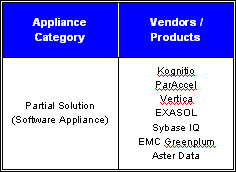Partial Data Warehouse Appliances (Software Appliances)
Starting in 2006, a new wave of vendors emerged that focus on database management systems (DBMS) purpose-built for data warehousing that easily integrate with another vendor’s hardware. The products from these “partial-solution” data warehouse appliance vendors have been coined as “software appliances”. The software appliance has proved to be a good starting point for new data warehouse vendors. It allows them to focus on their strength, database software, and to partner with commodity hardware vendors and benefit from the hardware firms’ focus and resources.
- The partial solution vendor is typically a software company that has developed a proprietary database and either partners with or is a subsidiary of one or more major hardware vendors. These software vendors generally focus on the development of an optimal database management software that is suitable for large data warehouse implementations, and commonly rely on other vendors to supply the most-appropriate hardware.
Software appliance vendors with products based upon the traditional row-based database model:
- Kognitio – Offers a row-based “virtual” database called WX2 that does not include indexes or data partitions and runs on blade servers from IBM and hardware from Hewlett-Packard. Kognitio can be deployed to a customer in one of three ways: as a software-only license solution, as a fully configured data warehouse appliance, and on-demand via a Data Warehousing as a Service (DaaS) offering.
Software appliance vendors with products based upon the columnar database model in which data is stored in columns rather than rows:
- ParAccel – The ParAccel Analytic Database is a proprietary column-based database that combines patent-pending innovations with a columnar, compressed, massively parallel, all-in-memory-capable architecture. The database is available as a packaged appliance on Sun hardware known as Ultra-Fast Data Warehouse powered by Sun and ParAccel.
- Vertica – The Vertica Analytic Database is a grid-based, column-oriented database that runs on grids of commodity Linux-based servers. It features column-oriented storage organization, compression, hybrid storage organization, and a shared nothing architecture. In March 2011, Hewlett Packard (HP) completed an acquisition of Vertica Systems, Inc.
- EXASOL – Offers a proprietary, massively parallel database management system called EXASolution. The product is column-based and makes extensive use of in-memory processing. Join indexes are automatically generated at run-time, as required. EXASolution is available either as a software only solution or as a pre-configured appliance running on commodity hardware such as Fujitsu Siemens, HP, Supermicro or Hitachi. EXASolution uses its own version of Linux which provides extended capabilities to support its clustered architecture.
- Sybase IQ – Distinguishes itself from conventional databases with its column-oriented, grid-based architecture, patented data compression, and advanced query optimizer. Sybase IQ provides significantly faster query performance than traditional database environments which were designed primarily for processing transactions. The improvement over such solutions can be 10 to 1000 times greater, even as thousands of users and years worth of data are added to the environment. Announced in May 2008, Sybase Analytical Appliance combines pSeries hardware from IBM with the Sybase IQ database.
Software appliance vendors with products based upon a hybrid row and column database:
- EMC Greenplum – Acquired in July 2010 by EMC, Greenplum has become the foundation of EMC’s Data Computing Division. Moreover, the EMC Greenplum database contains a shared-nothing, massively parallel processing (MPP) architecture that has been purpose-built for business intelligence and analytical processing.
- Aster Data – Provides a database management system (DBMS) called Aster Data nCluster, which is a massively parallel (MPP) hybrid row and column database with an integrated analytics engine. Aster Data’s solution utilizes Aster Data’s patent-pending SQL-MapReduce to allow for parallel processing of data and applications and to deliver rich, analytic insights. Aster Data products can be deployed to a customer in one of three ways: Software-only, Cloud-based, and Complete-appliance called Aster Data MapReduce DW Appliance. In April 2011, Teradata completed its acquisition of Aster Data Systems, Inc.



Sweet.